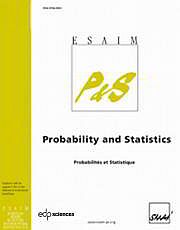Crossref Citations
This article has been cited by the following publications. This list is generated based on data provided by Crossref.
Duncan, T.E.
and
Pasik-Duncan, B.
2008.
Adaptive Control of a Scalar Linear Stochastic System with a Fractional Brownian Motion.
IFAC Proceedings Volumes,
Vol. 41,
Issue. 2,
p.
4096.
Kleptsyna, Marina L.
Le Breton, Alain
and
Viot, Michel
2008.
Separation principle in the fractional Gaussian linear-quadratic regulator problem with partial observation.
ESAIM: Probability and Statistics,
Vol. 12,
Issue. ,
p.
94.
Duncan, T. E.
Maslowski, B.
and
Pasik‐Duncan, B.
2009.
Solutions of linear and semilinear distributed parameter equations with a fractional Brownian motion.
International Journal of Adaptive Control and Signal Processing,
Vol. 23,
Issue. 2,
p.
114.
Duncan, T. E.
and
Pasik-Duncan, B.
2009.
Control of some linear stochastic systems with a fractional Brownian motion.
p.
8518.
Duncan, Tyrone E.
and
Pasik-Duncan, Bozenna
2013.
Linear-Quadratic Fractional Gaussian Control.
SIAM Journal on Control and Optimization,
Vol. 51,
Issue. 6,
p.
4504.
Guevara, Karen
and
Fragoso, Marcelo D.
2017.
Optimal control for linear quadratic problems with Markov jump parameters and fractional brownian perturbation.
p.
5906.
Coupek, Petr
Duncan, Tyrone E.
Maslowski, Bohdan
and
Pasik-Duncan, Bozenna
2018.
An Infinite Time Horizon Linear-Quadratic Control Problem with a Rosenblatt Process.
p.
4973.
Kabluchko, Z. A.
and
Lifshits, M. A.
2019.
Adaptive energy-saving approximation for stationary processes.
Izvestiya: Mathematics,
Vol. 83,
Issue. 5,
p.
932.
Kabluchko, Zakhar Al'bertovich
and
Lifshits, Mikhail Anatolievich
2019.
Адаптивная энергетически эффективная аппроксимация стационарных процессов.
Известия Российской академии наук. Серия математическая,
Vol. 83,
Issue. 5,
p.
27.
Duncan, T. E.
Maslowski, B.
and
Pasik-Duncan, B.
2019.
Linear Stochastic Differential Equations Driven by Gauss-Volterra Processes and Related Linear-Quadratic Control Problems.
Applied Mathematics & Optimization,
Vol. 80,
Issue. 2,
p.
369.
Pasik-Duncan, Bozenna
and
E. Duncan, Tyrone
2024.
Adaptive Control Theory and Applications.


